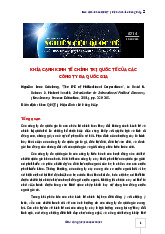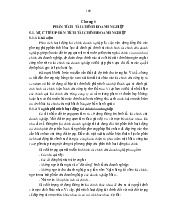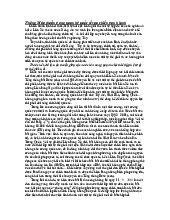









Preview text:
European Union | Energy profile, April 2021
Energy efficiency trends and policies Overview
Final energy consumption is growing again since 2014 with the economic growth rebound (+1%/year), recovering
its 2000 level at around 950 Mtoe. It has been increasing until 2007 (+0.6%/year over 2000-2007) and decreasing
between 2007 and 2014 because of the economic crisis (-1.2%/year). The share of transport in final energy
consumption has increased (from 27% in 2000 to 30% in 2018), as for services (from 12 to 14%). On the other
hand, the share of industry has decreased by almost 4 percentage points, from 31% in 2000 to 27% in 2018.
Households’ share is rather stable (26%), as wel as that of agriculture (3%).
Figure 1: Final energy consumption by sector (normal climate) Source: ODYSSEE
Energy efficiency of final consumers, as measured by ODEX indicator, improved by 1.1%/year between 2000 and
2018, i.e. by 18% over the period. Larger gains have been achieved for households (1.8%/year) with a net
slowdown since 2015 (1.1%/year against 1.9%/year before). The rate of energy efficiency improvement has
almost halved in industry since the economic crisis (-0.9%/year since 2007 compared to 1.6%/year before). The
transport sector has progressed the least: only by 10% since 2000, that is 0.6%/year. There was few “measurable”
progress in services before 2010; since then, energy efficiency is improving by 1%/year.
The sole responsibility for the content of this document lies with the
authors. It does not necessarily reflect the opinion of the European Union.
Neither the EASME nor the European Commission are responsible for any
use that may be made of the information contained therein
European Union | Energy profile, April 2021
Figure 2: Technical Energy Efficiency Index Source: ODYSSEE
Within the "Clean Energy for al Europeans package", eight legislative acts entered into force between May 2018
and May 2019. Concerning energy efficiency, especial y the revisions of the EPBD (EU 2018/844) and the EED (EU
2018/844) were important. The revised EED both includes a tightened target for energy efficiency of at least
32.5% by 2030 (Article 3) and a new target for the energy savings obligation under Article 7 for the obligation
period 2021-2030.The future energy efficiency policy wil be driven by the "European Green Deal", presented by
the Commission in December 2019. As part of the Green Deal, the Commission proposed a tightening of the
greenhouse gas reduction target from 40% to 55% by 2030 (compared to 1990) and a “European Climate Law".
The “Fit for 55” legislative package, which is part of the Commission's 2021 work program, includes twelve
directives and regulations to be adapted. Of particular relevance for energy efficiency are the planned revisions
of the Emission Trading System (ETS), the Effort Sharing Regulation (ESR), the Energy Taxation Directive, the CO2
emission standards for vehicles, and the EPBD and EED. According to the Impact Assessment, another tightening
of the energy efficiency target wil be necessary.
Table 1: Sample of cross-cutting measures Measures NEEAP Description
Expected savings, impact More information measures evaluation available (Amended) yes
The new amending Directive on Expected final energy https://ec.europa.eu/en Energy
Energy Efficiency (EU 2018/844) consumption in 2030 ergy/topics/energy- Efficiency
updated the energy efficiency (compared to a BAU- efficiency/targets- Directive
policy framework to 2030. The Scenario): not more than directive-and- (EED)
key element is the new headline 846 Mtoe (without UK) rules/energy-efficiency- target for energy efficiency. directive_en Source: MURE
The sole responsibility for the content of this document lies with the
authors. It does not necessarily reflect the opinion of the European Union.
Neither the EASME nor the European Commission are responsible for any
use that may be made of the information contained therein
European Union | Energy profile, April 2021 Buildings
Heating is by far the largest end-use for households (64% in 2018). The heating consumption of households per
m2 has been decreasing by 1.7%/year thanks to the tightening of building codes, coupled with financial
incentives to promote thermal retrofitting of existing dwel ings and the adoption of more efficient heating
systems. The energy consumption per dwel ing decreased less than the consumption per m2 (by 0.9%/year and
1.3%/year respectively) because of an increase in the average dwel ing size (+0.4%/year since 2000). The shares
of cooking and water heating are decreasing while electrical appliances account for a higher share; the share of
air conditioning (AC) is stil marginal.
Figure 3: Energy consumption of space heating per m2 (normal climate) Source: ODYSSEE
Figure 4: Energy consumption per dwelling by end-use (except space heating) Source: ODYSSEE
The sole responsibility for the content of this document lies with the
authors. It does not necessarily reflect the opinion of the European Union.
Neither the EASME nor the European Commission are responsible for any
use that may be made of the information contained therein
European Union | Energy profile, April 2021
In 2018, energy consumption of households was slightly below its 2000 level (-7 Mtoe or around 3%). Three main
factors contributed to increase energy consumption over the period: a growing number of dwel ings (+36 Mtoe),
larger homes (+19 Mtoe) and an increasing number of appliances (+15 Mtoe). Energy savings (83 Mtoe) more
than offset the effect of these factors.
Figure 5: Main drivers of the energy consumption variation of households Source: ODYSSEE
The energy consumption per employee has overal been decreasing since 2010 (-1.6%/year) and is slightly below
its 2000 level in 2018 (0.87 toe). It increased during the period of low economic growth (200 - 7 2010) (+1.6%/year)
as the consumption decrease did not fol ow the activity slowdown. The electricity consumption per employee
increased by 1.7%/year until 2010 and has been decreasing afterwards (-0.9%/year) down to around 5000 kWh in 2018.
Figure 6: Energy and electricity consumption per employee (normal climate) Source: ODYSSEE
The sole responsibility for the content of this document lies with the
authors. It does not necessarily reflect the opinion of the European Union.
Neither the EASME nor the European Commission are responsible for any
use that may be made of the information contained therein
European Union | Energy profile, April 2021
The legislative framework for the European building sector is set by two key regulations. The Energy Performance
of Buildings Directive (EPBD) was first introduced in 2010 (2010/31/EU), the Energy Efficiency Directive (EED) in
2012 (2012/27/EU). Both Directives were amended in 2018 (amended EPBD: 2018/844/EU; amended EED:
2018/1999/EU). Another amendment is announced in the “Fit for 55” package.
Electrical appliances are regulated by energy label ing and ecodesign requirements. A new Energy Label ing
regulation (2017/1369/EU) was adopted in July 2017, replacing the former Label ing Directive (2010/30/EU). It
includes several new issues, such as a reintroduction of the original A-G scale for label ing and a new database
(EPREL). The label ing framework covers 15 product groups, most of them related to the household sector. The
ecodesign requirements for individual product groups are created under the EU's Ecodesign Directive
(2009/125/EC) in a structured process coordinated by the European Commission. The EU legislation on ecodesign
is applicable on 31 product groups, of which the majority is related to buildings. On 1 October 2019, the
Commission adopted 10 Ecodesign Implementing Regulations of which eight revised existing requirements
(refrigerators, washing machines, dishwashers, electronic displays, light sources, external power suppliers,
electric motors, power transformers) and two new regulations (refrigerators with direct saled function, welding equipment).
Table 2: Sample of policies and measures implemented in the building sector Measures Description
Expected savings, impact More information evaluation available Amended
With the amendment of the former EPBD Reduction of annual final https://ec.europa.eu/e Energy
from 2010 in 2018, some new measures were energy use in 2030: 28 nergy/topics/energy-
Performance introduced to modernise the EU's building Mtoe. Reduction of CO2 efficiency/energy- of Buildings
sector and to increase the renovation rates. emissions: 38 Mt. Result efficient- Directive
These measures include long-term renovation of Impact assessment buildings/energy- (EPBD)
strategies to be delivered by the MS, (preferred Option) performance-
Minimum energy Performance Standard for buildings-directive_en new and existing buildings, energy
performance standards for buildings as wel
as the nearly zero-energy buildings (NEZEB)
standard for new buildings from 31 December 2020. Source: MURE
The sole responsibility for the content of this document lies with the
authors. It does not necessarily reflect the opinion of the European Union.
Neither the EASME nor the European Commission are responsible for any
use that may be made of the information contained therein
European Union | Energy profile, April 2021 Transport
The distribution of transport energy consumption by mode has remained almost stable since 2000, road
transport accounting for around 94%. Cars represent 56% of the sector's consumption and road freight transport
(trucks and light duty vehicles) 33% in 2018.
Figure 7: Transport energy consumption by mode Source: ODYSSEE
Passenger traffic increased by 14% since 2000, to reach around 5200 Gpkm in 2018. The share of public transport
remained stable (around 19%). This stability is the result of opposite trends in Member States, with a decrease in
the majority of countries (60%) but an increase in some of the largest countries (e.g. Italy and France).
Figure 8: Modal split of inland passenger traffic Source: ODYSSEE
The sole responsibility for the content of this document lies with the
authors. It does not necessarily reflect the opinion of the European Union.
Neither the EASME nor the European Commission are responsible for any
use that may be made of the information contained therein
European Union | Energy profile, April 2021
Freight traffic increased by 24% since 2000 to reach around 2300 Gtkm in 2018. The share of rail and water traffic
(25% in 2018) has decreased at EU level (-4 points), despite the policies implemented to promote these modes.
Figure 9: Modal split of inland freight traffic Source: ODYSSEE
The consumption of transport increased by 22 Mtoe since 2000. The growth in passenger and freight traffic
contributed to increase energy consumption (by 43 Mtoe). Energy savings (i.e. efficiency improvement of cars,
trucks, etc.) counterbalanced two thirds of this effect by decreasing energy consumption by 27 Mtoe. Modal shift
from bus to private car and from rail to road for freight led to a 5 Mtoe rise in consumption.
Figure 10: Main drivers of the energy consumption variation in transport Source: ODYSSEE
The sole responsibility for the content of this document lies with the
authors. It does not necessarily reflect the opinion of the European Union.
Neither the EASME nor the European Commission are responsible for any
use that may be made of the information contained therein
European Union | Energy profile, April 2021
The key Directives to increase energy efficiency and reducing CO2 emissions in road transport are mandatory
emission reduction targets for new vehicles. For new cars, such targets have been set since 2009 (Regulation
443/2009/EC), for vans since 2011 (Regulation 510/2011/EU). From 1 January 2020, new CO2 standards are in
place for new cars and vans for 2025 and 2030 (Regulation (EU) 2019/631). In 2019, CO2 emission standards have
also been adopted for heavy-duty vehicles (Regulation 2019/1242/EU), setting targets for new lorries for 2025
and 2030. Regarding CO2 emissions of aviation, they have been included in the EU emissions trading system since
2012. An amendment both of the ETS and the CO2 vehicle standards is foreseen in the “Fit for 55” package.
Table 3: Sample of policies and measures implemented in the transport sector Measures Description
Expected savings, More information
impact evaluation available CO2 emission
The Regulation sets new EU fleet-wide CO2 GHG emission https://ec.europa.
performance standards emission targets for the years 2025 and 2030 reduction in 2030 eu/clima/policies/
for new passenger cars for newly registered passenger cars and vans. (comp. to 2005): transport/vehicles and for new light
The targets are defined as a percentage 23% /regulation_en commercial vehicles
reduction: for cars 15% reduction from 2025 (Regulation (EU)
and 37.5% from 2030; for vans 15% reduction 2019/631) from 2025 and 31% from 2030. CO2 emission
The regulation sets CO2 emission standards for Annual CO2 https://ec.europa.
performance standards heavy-duty vehicles by Setting targets for reduction by 2030: eu/clima/policies/ for new heavy-duty
reducing the average emissions from new 54 Mt. transport/vehicles vehicles (Regulation
lorries for 2025 and 2030. The Regulation also /heavy_en (EU) 2019/1242)
includes a mechanism to incentivise the uptake
of zero- and low-emission vehicles, in a technology-neutral way. Source: MURE
The sole responsibility for the content of this document lies with the
authors. It does not necessarily reflect the opinion of the European Union.
Neither the EASME nor the European Commission are responsible for any
use that may be made of the information contained therein
European Union | Energy profile, April 2021 Industry
Since 2000, energy consumption has decreased in al industrial branches. Chemical and steel industries are the
main energy consuming branches (respectively 20% and 18% of total industry consumption in 2018); while the
share of chemicals is increasing (+2 points since 2000), the share of steel is declining (-3 points).
Figure 11: Final energy consumption of industry by branch Source: ODYSSEE
After a sharp decrease over 2000-2007 (-1.9%/year), the specific consumption of steel has been almost stable
since 2007. The specific consumption of pulp and paper decreased slightly since 2000 (-0.2%/year). The specific
consumption of cement fel sharply between 2000 and 2006 (-2.6%/year) before rebounding during the crisis.
Since 2014, it has decreased again (-1.2%/year).
Figure 12: Unit consumption of energy‐intensive products (toe/t) Source: ODYSSEE
The sole responsibility for the content of this document lies with the
authors. It does not necessarily reflect the opinion of the European Union.
Neither the EASME nor the European Commission are responsible for any
use that may be made of the information contained therein
European Union | Energy profile, April 2021
The industry energy consumption decreased by around 35 Mtoe between 2000 and 2018. This is mainly due to
energy savings (60 Mtoe) and to a lesser extent to structural effects (21 Mtoe), i.e. the fact that less intensive
branches increased their contribution in industrial value added. Growth in industrial activity (measured with the
production index) had a relatively limited effect (32 Mtoe), due to the recession over 2007-2013.
Figure 13: Main drivers of the energy consumption variation in industry Source: ODYSSEE
The key regulation for energy-intensive industries is the emissions trading system (ETS). The legislative
framework for the current trading period (phase 4 from 2021-2030) was revised in early 2018. Another revision is
foreseen in the “Fit for 55” package. Industrial cross-cutting technologies (as e.g. circulators, electric motors,
computers and servers, fans) are regulated by the EU's Ecodesign Directive (2009/125/EC). A key funding
programme for industry is the EU Innovation Fund for demonstration of innovative low-carbon technologies.
Table 4: Sample of policies and measures implemented in the industry sector Measures Description
Expected savings, More information
impact evaluation available EU Emission
The "cap and trade" system covers CO2 emissions https://ec.europa.eu/c
Trading System from power and heat generation, energy intensive lima/policies/ets_en (EU ETS)
industries as wel as commercial aviation. Source: MURE
The sole responsibility for the content of this document lies with the
authors. It does not necessarily reflect the opinion of the European Union.
Neither the EASME nor the European Commission are responsible for any
use that may be made of the information contained therein




